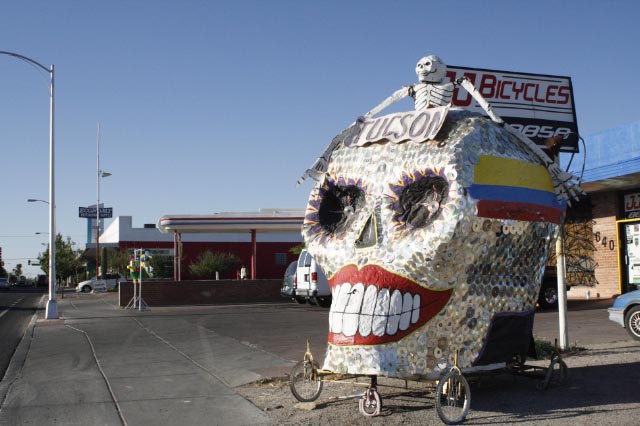(Soundbite of music and entering the shop)
Narrator: Jorge Gonzales, 53 from Manizales, Colombia sleeps in a small mattress on the floor of the Sculpture Resource Center in Tucson, Arizona. He uses his lifelong skills as a welder to pursue his dream of becoming a sculptor.
Gonzalez: (En nuestros paises de latino america,) In our Latin American countries we would see the landscapes here in the roadrunner and coyote cartoons so today I am making that real.
(Soundbite Welding sounds)
Gonzalez: (La esculptura va a ser “La hora de la Verdad,”) The sculpture is going to be called “The hour of truth, they meet to see what will happen.”
Narrator: Back in Colombia, Gonzales left behind the welding shop his father left him along with his wife and two teenaged sons.
Gonzalez: (Gracias a Dios encontre el sitio que yo queria.) Thank god I found the place that I wanted, a welding shop with other artists that helped me because I had never made art.
Narrator: When looking for a job at the bicycle shop next door in 2008, Gonzales stumbled upon this art space where he met two local artists, Joshua Woodhall and Ernest Espinoza.
Gonzalez: (Joshua es un pintor, y pinta y pinta y pinta,) Joshua, is a painter and he paints and paints and paints. It doesn’t matter where, he paints on paper, he paints on a piece of wood, he paints on the wall he paints on the floor, all he does all day is paint and draw.
Woodhall: My name is Joshua Woodhall. I’m a painter. I’m 34
Narrator: Woodhall was one of the local artists who inspired Gonzalez when he first arrived.
Woodhall: I was hit by a car when I was eleven and everything was erased from me; talking, walking, swallowing but I could still draw just like before the accident.
Narrator: Woodhall has devoted his entire life to art. He spends all day at the center working on becoming a famous artist.

La Calavera, or The Skull is a huge skull in front of the Sculpture Resource Center made of, among other things, hundreds of CDs. Jorge Gonzalez participated in making this sculpture. Kristian Hernández | NYT Institute
Woodhall: The ultimate goal is for some 13 year-old kid to look at a book that I’m in and say ‘Oh my god I have to paint’… and if I do that then I have succeeded.
Narrator: Ernesto Espinoza, 29 is like a younger brother to Woodhall. He’s one of the first members of this center. He studies mechanical engineering at the University of Arizona.
Espinoza: I am very mechanically inclined. I have made mechanical solutions when I was a little kid that have astounded adults and up to this day I am studying mechanisms and actions.
Narrator: In the middle of the backyard metal shop, an 8-ft black iron sculpture shadows everything around it. Ernie created the sculpture 3 years ago and named it after his mother Sue.
Espinoza: It’s a mechanical hammer with a big cam and spring action made from railroad track that I hacksawed. I wouldn’t have done that if it wasn’t for Jorge. One day he came in here and was like, in Columbia I can hacksaw a railroad track no problem in 45 minutes.
(Soundbite Mechanical Gears)
Narrator: Over the years the three artists have come across many who attempt to define them. They resist any notion that this special place they share can be labeled.
Espinoza: It’s very difficult to try to define this place, if you do you will begin to destroy it.

 During the Institute, students are working journalists supervised by reporters and editors from The New York Times and The Boston Globe. Opportunities for students include reporting, copy editing, photography, Web production, print and Web design, and video journalism. Institute graduates now work at major news organizations, including The Associated Press, The Los Angeles Times, The Washington Post and The New York Times itself, and dozens of midsize news organizations.
During the Institute, students are working journalists supervised by reporters and editors from The New York Times and The Boston Globe. Opportunities for students include reporting, copy editing, photography, Web production, print and Web design, and video journalism. Institute graduates now work at major news organizations, including The Associated Press, The Los Angeles Times, The Washington Post and The New York Times itself, and dozens of midsize news organizations.